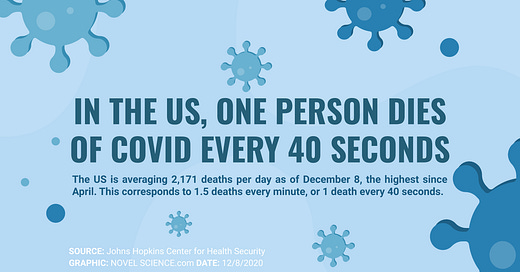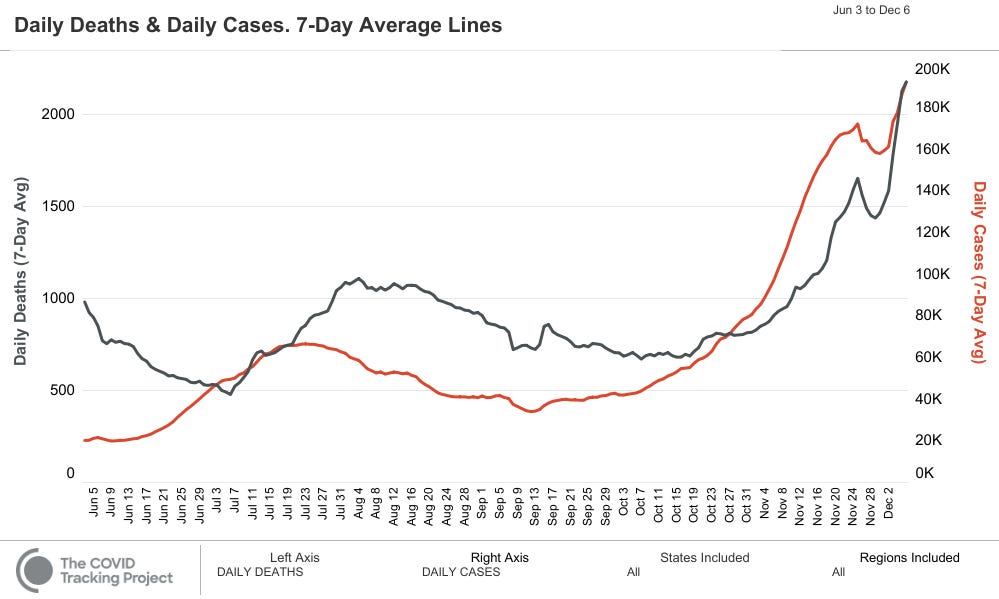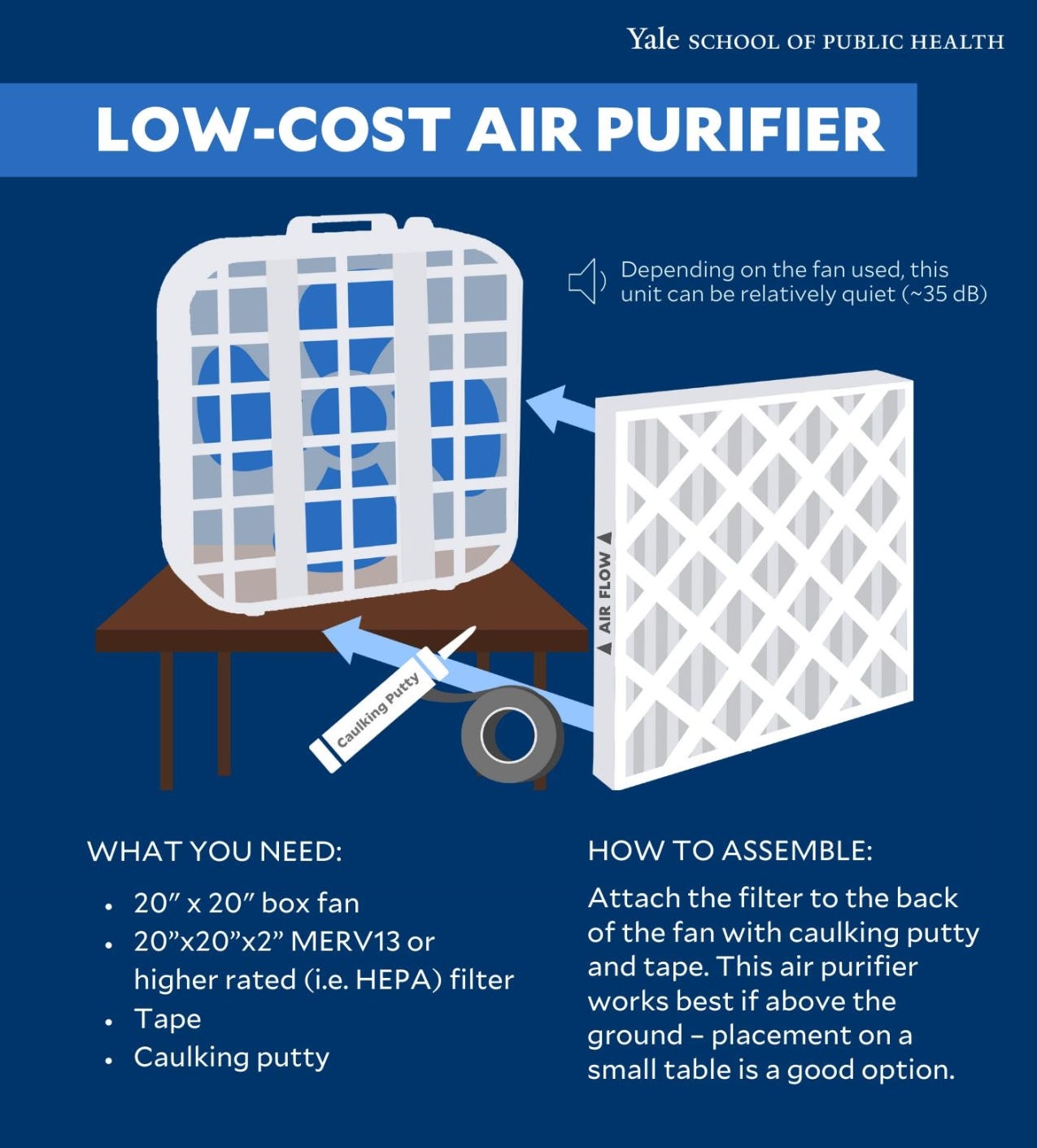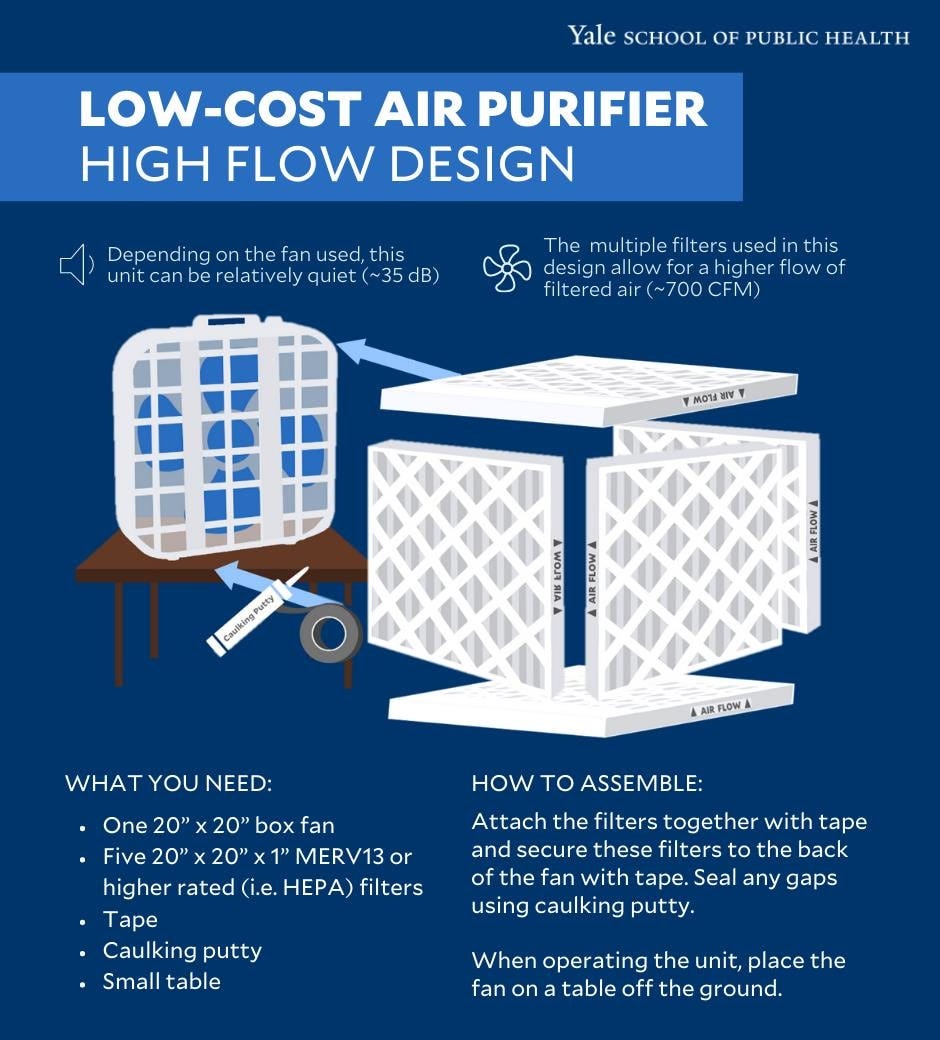Vaccines, a Covid DIY Lifehack, Holiday Impact on Cases, HHS Publishes New Data, and the US Gets Short-Changed on Vaccines
Science & Society Newsletter for Dec 8, 2020
Covid Situation Report
The US CDC reported for December 7th:
14.64 million total cases in the US
281,253 deaths total in the US
Noteworthy: 219,187 new cases on December 3, making it the first country to exceed 200,000 cases in a single day.
Cases
The US now ranks #11 globally in terms of per capita daily incidence, with 608 daily cases per million population. Of the 10 countries ahead of the US, 5 have populations of less than 1 million, and only Serbia (6.8 million) has a population greater than 5 million. Five (5) of those countries are averaging fewer than 600 total cases per day, and none are reporting more than 7,500.
From the first case reported in the US on January 22, it took 96 days to reach 1 million cases. Now, it takes 5 days, but it will be another week before we see the effect of Thanksgiving. If that interval shortens more we could have a period where we see 3,000-5,000 deaths per day and overall healthcare quality would decline. People with critical illnesses not related to Covid that were survivable may die because of a care delay.
0 to 1 million- 96 days
1 to 2 million- 44 days
2 to 3 million- 27 days
3 to 4 million- 15 days
4 to 5 million- 17 days
5 to 6 million- 22 days
6 to 7 million- 25 days
7 to 8 million- 21 days
8 to 9 million- 14 days
9 to 10 million- 10 days
10 to 11 million- 7 days
11 to 12 million- 5 days
12 to 13 million- 7 days
13 to 14 million- 5 days
Deaths
The US passed 275,000 cumulative deaths on December 3 as well. From the first death reported on February 29, it took 46 days to surpass 25,000 deaths.
0 to 25k deaths- 46 days
25k to 50k- 9 days
50k to 75k- 13 days
75k to 100k- 20 days
100k to 125k- 31 days
125k to 150k- 32 days
150k to 175k- 24 days
175k to 200k- 31 days
200k to 225k- 34 days
225k to 250k- 24 days
250k to 275k- 14 days
The US reported more than 2,300 deaths for 5 consecutive days for the first time ever, including 2,861 deaths on December 3, the third-highest daily total to date.
The US is currently averaging 2,171 deaths per day, the highest since April 25. This corresponds to 1.5 deaths every minute, or 1 death every 40 seconds. The US has only exceeded the current daily mortality for an 11-day period from April 15-25, at the peak of the first surge.
Case reporting shows that most states either recently had or are currently having their highest number of recorded cases in a single day.
While the midwest may be turning the curve—though there are indicators that suggest the decline may not be to the degree it appears—the South, the West—pretty much everywhere but Maine, New York, and Hawaii are seeing the worst of the pandemic.
As a reminder, the CDC data from last week included delayed cases and deaths over the Thanksgiving holiday weekend, which could have elevated figures in the past week.
Johns Hopkins Center for Health Security reports that it expects health departments and hospitals to resume normal reporting after catching up after the holiday, so this week will likely provide a more accurate representation of the current state of the US epidemic. It will be another week before we see the effect of Thanksgiving travel and gatherings.
A rough average for testing, hospitalization, and deaths timeline could look like:
Spreading Event
1/3 of those infected may never show symptoms or know they are infected.Testing: 1 week, usually prompted by symptoms—otherwise contact tracing.
Hospitalizations: 1-2 weeks
Deaths: 2-4 weeks
Moral of the story: Hospitalizations and Deaths lag cases. If cases go up, it’s likely the other two will also, but it takes time. Do not operate under the assumption deaths have gone down simply because they haven’t risen.
This two-factor graph shows deaths and cases. Deaths are to the left and cases are to the left. While cases took off after June 9th, the deaths did not begin to increase until almost a full month later in July. Unfortunately, many outlets published headlines emphasizing that the death rate had gone down despite infectious disease experts warning that deaths lagged and that this was likely a false narrative. It was. Deaths surged.
HHS Publishes Facility-Level Data on Hospitals
The US Department of Health and Human Services (HHS) published detailed, facility-level data on hospital capacity with respect to COVID-19. The data cover more than 2,000 hospitals nationwide, and initial analysis by COVID Tracking Project found that 126 counties are reporting bed availability at 10% or less, principally in Kentucky, Georgia, Minnesota, Oklahoma, and Texas. The release of local data provides a much more detailed look at COVID-19 hotspots than the state-level hospitalization data previously available.
Already we have this, which may help divert resources and show where policies are and are not working.
‘V-Day’ in the UK, Delays in the US
“It’s the best early birthday present I could wish for…”
This morning a 90-year-old shop clerk named Margaret Keenan received Britain’s first dose of the Pfizer/BioNTech COVID-19 vaccine as the country rolls out its fledgling vaccination program, starting with people over 80, AP reports.
BREAKING US NEWS
The Pfizer/BioNTech vaccine is safe and effective, according to a much-anticipated FDA analysis released this morning, priming vaccine for an emergency use authorization, NPR reports. Independent FDA advisors will convene Thursday to consider recommending the FDA grant the Pfizer vaccine a EUA.
President Trump plans to sign an executive order that aims to ensure Americans get priority access before doses are shipped abroad to help other countries, ABC reports.
Pfizer and Moderna—the companies behind the top 2 vaccine candidates—declined to attend President Trump’s vaccine summit, underscoring the rising acrimony between the administration and drugmakers.
This summer, the White House opted out of a deal to buy 100 million additional doses of the Pfizer vaccine, which may delay US delivery beyond the summer of 2021. The company must now fulfill its commitments to other countries, AP reports.
The executive order, which intervenes in the marketplace, may play a role in the distance growing between the administration and vaccine makers.
DIY LifeHack Compliments of Yale
Low-Cost Air Purifier
Noise: Depending on the fan used, this unit can be relatively quiet (~35 dB).
What you need:
20” x 20” box fan
20” x 20” x 2: MERV13 or higher rated (i.e. HEPA) filter
Tape
a sense of humor because it has come to this.
How to assemble:
Attach the filter to the back of the fan with caulking putty (optional, I didn’t use it) and tape. This air purifier works best if above the ground — placement on a small table is a good option.
I made one to see how it worked. It definitely filters the air. Like so many things in the pandemic I find experts say, it’s better than nothing. It’s a low bar, but if you are indoors there are good reasons to think this might help including studies showing this type of filter removing particles from the air in the size range we might find the virus. You can do it with one filter or for a higher volume of air, create the cube as depicted below.
Studies that suggest this may work:
Control of respirable particles in indoor air with portable air cleaners
Mitigating particulate matter exposure in naturally ventilated buildings during haze episodes
Effectiveness of In-Room Air Filtration and Dilution Ventilation for Tuberculosis Infection Control
NOTE: to quote an article from WIRED:
This isn’t science yet.
These aren’t peer-reviewed studies. This hasn’t been tested under ideal conditions multiple times. No one has run these stats. Caveat experimenter. Still, though—seems worth it. Right?
“Sure, absolutely. It’s an air purifier. It’s not a HEPA air purifier, but it’s a reasonably good air purifier,” Rosenthal says. “If that’s the only option, I’d rather see people do that than have nothing.”
Having an air filter does not remove the need to wear masks. Recently a study outlined the story of a man who stopped in a restaurant for 5 minutes. He managed to spread Covid to two people (Case A and Case C) sitting 15 and 20 feet away from him. Notice that this man (Case B) would not have mentioned the people at the restaurant were he interviewed by contact tracers who currently define close contacts as within 6 feet and for at least 15 minutes.
There is nothing special about those particular numbers, so more distance is always better, wear a mask, and don’t take people’s word on whether they’re infected.
Air can move the virus around indoors which is a reason why filtration of some kind may be worth it. This isn’t an endorsement, so much it is sharing that this may be helpful. We don’t have good evidence on it but past evidence says it might help. The possible unintended effect of dispersing the virus, while not seen in studies for other diseases, cannot be ruled out and DIY filter-fan users must be advised, however unlikely that is.
Goings-on About the Government
PRESS RELEASE
NIH-funded Tool Helps Organizations Plan COVID-19 Testing A team led by the Consortia for Improving Medicine with Innovation and Technology (CIMIT) at Massachusetts General Hospital, Boston, and researchers at the Massachusetts Institute of Technology (MIT), Cambridge, developed the tool to model the costs and benefits of COVID-19 testing strategies for individual organizations. The team developed their mathematical model and calculator as part of NIH’s Rapid Acceleration of Diagnostics (RADx) Tech program. The calculator is simple--a user enters a few specifics about their site and the tool produces customized scenarios for surveillance testing. The tool models four different COVID-19 testing methods, including onsite and lab-based, and calculates the number of people to test each day. It shows the estimated cost of each testing option and outlines the tradeoffs in the speed and accuracy of each kind of test. (NIH, 12/7/2020).
PRESS RELEASE
FDA Authorizes First COVID-19 and Flu Combination Test for Use with Home-collected Samples The US Food and Drug Administration authorized the first diagnostic test for at-home collection of patient samples to detect both COVID-19 and influenza A and B. The FDA authorized Quest Diagnostics RC COVID-19 +Flu RT-PCR Test for prescription use with the Quest Diagnostics Self-Collection Kit for COVID-19 +Flu by individuals who are suspected of respiratory viral infection consistent with COVID-19 when at-home collection is determined to be appropriate by an individual’s healthcare provider. Under a health care provider’s order, patients can collect a sample at home and ship it to a Quest Diagnostics laboratory for analysis following the instructions included with the self-collection kit. (FDA, 12/4/2020)
Recommended Reads:
from NOVEL SCIENCE
Words That Work When Talking About Coronavirus AN INFOGRAPHIC EXPLAINER:
from outside sources
To Control COVID, Biden Needs to Marshal Federal Resources—and Change Attitudes from Scientific American
The incoming U.S. president must help skeptics see benefits in masks, and persuade Congress to spend more money on testing and protective gear.
Does the World Need a New Global Health Organization? from Foreign Affairs
We at Foreign Affairs have recently published a number of pieces on global health organizations and the COVID-19 pandemic. To complement these articles, we decided to ask a broad pool of experts for their take.
Here’s Why Vaccinated People Still Need to Wear a Mask from the New York Times. The new vaccines will probably prevent you from getting sick with Covid. No one knows yet whether they will keep you from spreading the virus to others — but that information is coming.
Johns Hopkins releases online guidance for schools returning to in-person learning
The Johns Hopkins Bloomberg Schools of Public Health and Medicine on Monday released an online educational series that aims to guide school and district officials nationwide, on best practices to reduce COVID-19 risks, when they decide it's time to have students and teachers return for in-person learning.
Credit for analyses to Johns Hopkins Center for Health Security and to Amanda Kobokovich’s Preparedness PulsePoints for the government briefings. Thanks to the Covid Tracking Project for its tireless effort in making freely available data visualization and quality data sets.













